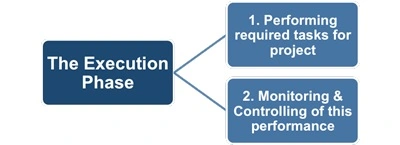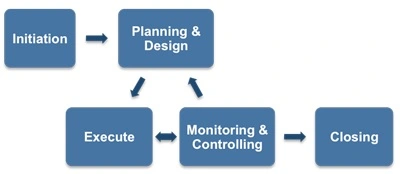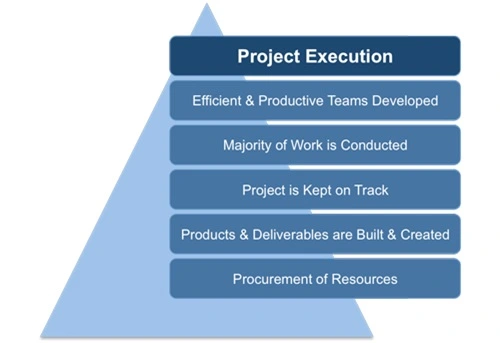The whole point of a project is to produce deliverables of some sort and the execution phase is where this happens. Essentially, work is done according to the project plan and that work is monitored and the results fed back to the people responsible for the plan so that it can be updated to reflect the progress made.

It is possible to see this phase of the project as consisting of two processes: the ‘doing’ or executing, and the monitoring and controlling.

This phase is often called ‘Execution and Control’ because it does not represent a blind implementation of the initial project plan but rather a cyclical process. As you can see from the diagram above, the planning, executing, and the monitoring and controlling processes are all interdependent.
Executing consists of the processes used to complete the work defined in the project plan to accomplish the project’s requirements. Execution process involves coordinating people and resources, as well as integrating and performing the activities of the project in accordance with the project plan. The main output of project execution is the project deliverables and producing these will be the responsibility of the project team who will be working to the project plan.
The actions performed during this process include
1) Performing the activities needed to meet the project objectives
2) Obtaining and manage quotations, bids and proposals as needed
3) Managing the project team and manage other resources
4) Collecting and analyze performance data
5) Generating project data for status reports and forecasts
6)Managing risks
7) Conducting change control and implementing approved changes
8) Establishing and managing project communication channels
9) Collecting and documenting lessons learned
Monitoring and controlling consists of monitoring project execution so that potential problems can be identified in a timely manner and corrective action taken as necessary. Monitoring and controlling includes measuring the ongoing project activities and the project variables (cost, effort, scope, etc.) against the project plan and the project performance baseline. It then identifies what needs to be done in order to get the project back on track. Over the course of any project, the scope may change either as the result of necessary design modifications, differing site conditions, material availability, contractor-requested changes, value engineering and impacts from third parties, to name a few.

The change normally needs to be documented to show what was actually done; this is referred to as change management.
No matter how carefully planned a project has been, changes will need to be made as it progresses. These will result from both external influences as well as problems that arise within the project environment. The four main sources of change are:
Organizational: High level business decisions may change the basic terms of reference of the project – for example there may be a change to the overall scope of the project.
Environmental: resulting from changes in legislation or changes in government policy or changes in business strategy.
Technical: New technology may offer a better solution to that originally planned. Alternatively, technical problems may prevent a product from working in the way that it was supposed to.
End-User: resulting from changes in customer requirements. It is also possible that feedback gained during the review or testing of a product may show that it is unsuitable in some unexpected way.
Apart From above, other parameters are as follows.
Managing the Project Team
Directing and Managing the Project Work
Managing Project Quality Assurance
Managing Communication with Project Stakeholders
Managing the Suppliers to the Project.

Key Points
- Project execution involves:
1. Establishing and managing the project team.
2. Coordinating people and resources.
3. Monitoring team performance.
4. Contracting procurements.
5. Directing and managing project execution.
6. Distributing information.
7. Performing quality assurance activities.
- The items produced by project execution are:
1. The risk and issue management responses plus corrective actions.
2. The deliverables themselves plus work performance information.
3. Change requests.
4. Negotiation and influence to ensure appropriate staff are assigned.
5. Motivation building and mentoring to ensure the team performance.
6. Conflict resolution and problem solving.
7. Procurements and contracts are negotiated and put in place.
8. Organizational process assets are updated as a result of executing the project plan.




